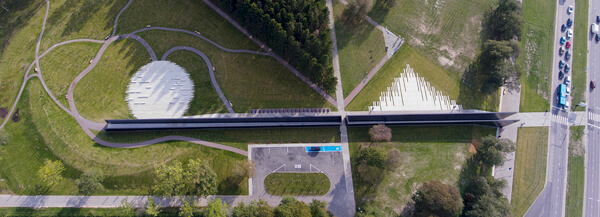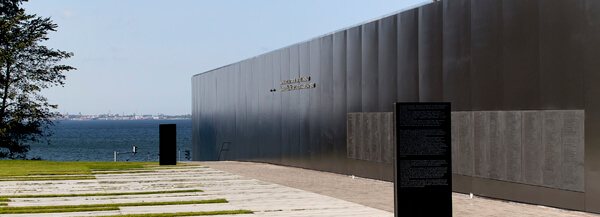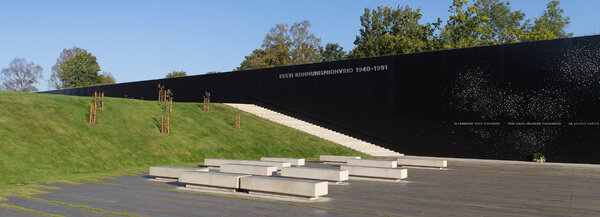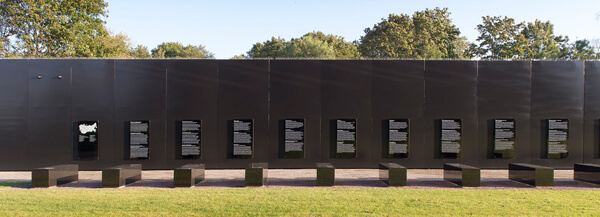The sites of memory of the communist terror, Patarei Prison, the prison cells on Pagari Street, and the Scheel lot in Tallinn, and Tartu Prison, are only the first four of many sites of suffering in Estonia, where Estonians were detained and murdered. Yet in most cases, political prisoners were sent far away to the Soviet Union into imprisonment and forced labour. The location stones situated at the Memorial mark the primary sites of imprisonment and places of exile as deportees for Estonian people. Up to five banishment districts with the largest numbers of deportees are indicated in each region.
There are information texts on the outer wall of the Memorial, which present the main facts concerning the communist terror and human losses in Estonia.
The Soviet Union’s occupying authorities immediately began imprisoning people on occupying Estonia in June of 1940, and they arrested at least 9,856 people in the twelve months that followed. The first victims were Estonia’s political elite and military leadership, officers and police officials along with patriotic citizens who resisted the occupying regime. Approximately 2,000 others were arrested in 1941–1944 from those who had been evacuated to the rear area in the Soviet Union or had been conscripted into the Red Army.
On 14 June 1941, the Soviet occupying regime committed its first act of genocide against the Estonian people. A secret decision by the Soviet government determined categories of people who were to be deported. The families of the Estonian elite became its first victims, including 2,578 children. A second deportation from the Western Estonian islands followed in July. Most of the heads of families were subsequently murdered or died in forced labour camps. Thousands of their family members died during the forced resettlement due to illness and starvation in inhumane conditions. In total, over 10,000 people were taken from Estonia to Russia in cattle cars in 1941.
Among the first to be deported were the Commander-in-Chief of the Armed Forces Johan Laidoner on 19 July 1940, and the President of the Republic of Estonia Konstantin Päts on 30 July 1940. All former heads of state of Estonia who had remained in their homeland suffered under the Red Terror. Four of them – Friedrich Karl Akel, Jüri Jaakson, Jaan Tõnisson and Jaan Teemant – were murdered, and four died in imprisonment. Of the seventy-eight former cabinet ministers who had remained in occupied Estonia, 64 were arrested. 70 of the 120 members of the last Estonian parliament were imprisoned along with nine of the eleven county governors.
In 1940, 133 higher state civil servants served in the government apparatus, 44 of whom were arrested. Eight of the 17 highest-ranking civil servants were imprisoned during the first year of the Soviet occupation. The imprisonments began with the highest-ranking police officials. The Chancellor of Justice and the Secretary of State were arrested and died in imprisonment in Russia. Most of the individuals who were arrested were murdered or died in inhuman conditions over the next couple of years. Those who managed to return to their Estonian homeland were forced to give up their occupation, to live in hardship and were in constant fear.
The first covertly committed executions of people in groups began in Estonia on 5 April 1941. After war broke out on 22 June, the campaign of terror intensified even further. Executions were carried out in Tallinn in the Estonian NKVD headquarters on Pagari Street, in the “Kawe” cellar, at Patarei Prison and in Pirita-Kose. As the front line approached, political prisoners were murdered at Viljandi Prison, Kuressaare Castle, and elsewhere. The largest mass murder was the execution of 193 prisoners at Tartu Prison on 8 and 9 July 1941. The NKVD, Red Army soldiers and members of the Soviet destruction battalions killed hundreds of innocent people. At least 2,446 people in total were murdered in Estonia in 1941.
In complete disregard for international law, nearly 45,000 citizens of the Republic of Estonia were forcibly mobilised into the Red Army in 1940–1941. In September of 1940, 9,826 men who had until then served in the Estonian Army were formed into the 22nd Red Army Rifle Corps. After the outbreak of war with Germany, approximately 35,000 more citizens of the Republic of Estonia were mobilised into the Red Army in the summer of 1941. At least 963 of the men mobilised into the Red Army were executed, another 2,463 were arrested and 3,616 went missing. A further 6,000–8,500 Estonians died in inhuman conditions in labour battalions. This was the biggest war crime in the first year of the Soviet occupation.
People arrested in Estonia were forcibly removed from their homeland to GULAG prison camps in distant regions of the Soviet Union with harsh climates. Prisoners were forced to perform extremely hard physical labour, including mining, logging work and construction. Political prisoners were transferred to separate strict-regimen camps in 1948. Forced labour beyond the strength of the prisoners, starvation, inhuman living conditions and violence took the lives of thousands who had been taken from Estonia to the GULAG. The executions of prisoners and the death rate among prisoners were highest in 1942.
In the spring of 1942, the mass execution of Estonians began at the NKVD internal prison in Sverdlovsk (currently Yekaterinburg). Over the course of the year, at least 684 Estonians were murdered.
The former head of state Jüri Jaakson and cabinet ministers Jaan Hünerson, Oskar Kask, August Kerem, Hugo Kukke, Paul Lill, Theodor Pool, Johannes Zimmermann and Nikolai Viitak were among those executed. Twelve women were executed, including the leaders of the women’s voluntary defence organisation Alice Kuperjanov, Ebba Saral and Salme Noor. Estonians were also executed en masse in Kirov, Irkutsk, Norilsk and Solikamsk in 1941 and 1942.
After the occupation of Estonia in June of 1940, Estonian cadre officers and members of the Estonian Defence League were among the first to fall victim to communist terror. The terror culminated in June of 1941, when over 350 cadre officers, who had been incorporated into the Red Army, placed in reserve or sent into retirement, were imprisoned at the same time as the deportation of civilians was being carried out. The campaign of terror directed against these Estonian military men, whom the Soviets considered unreliable, continued in 1941 at the front and in the rear area in the Soviet Union in labour battalions and in the Red Army’s Estonian national military units.
In the autumn of 1944, fear of the Red Terror forced about 80,000 people to flee from Estonia. Among them were civilians and soldiers who had been evacuated to Germany, and people who had made for Finland and Sweden as boat refugees. Over 5,000 refugees died, mostly in the Baltic Sea or during the bombing of Germany’s cities. The expatriate Estonian communities in many countries began the struggle to liberate Estonia from the communist regime. Over 20,000 Estonians were brought back to occupied Estonia forcibly or by deception. Several thousand of them were arrested on arrival in their homeland.
The policies of the Soviet Union’s occupying authorities and in particular the deportation of June 1941 gave rise to an active resistance movement. Thousands of people took to the forests and started armed resistance. After war broke out between the Soviet Union and Germany, Forest Brothers (patriotic Estonian partisans) engaged retreating units of the Red Army, NKVD troops and members of the destruction battalions in combat. Armed resistance continued after the second Soviet occupation of Estonia in 1944 and did not die out until the 1950s. During and after World War II at least 10,457 Estonians fell in the battles against the communist Soviet Union.
The communist campaign of terror continued in Estonia in the autumn of 1944. Over 16,000 people were imprisoned in 1944–1945. The Soviet secret police paid particular attention to pursuing the Estonian government led by Otto Tief, which had been sworn into office in September 1944, and its associates, and other independence-minded people. Over 35,000 people in total were imprisoned after the re-occupation of Estonia. Nearly 500 of them were sentenced to death and murdered. Thousands more died in the GULAG.
The communist terror forced people to hide in the forests and to fight as Forest Brothers in the name of Estonian independence. About 15,000 people operated as Forest Brothers until the second half of the 1950s. Their largest association was the League of Armed Struggle. The Soviet state security organs murdered or imprisoned freedom fighters and terrorised their supporters. Over 10,000 Forest Brothers in total were imprisoned, and nearly 2,000 of them were murdered in the woods. The resistance movement died out after Stalin’s death and the halting of mass terror. The last Forest Brother perished in the course of his arrest in 1978.
The deportation carried out on 25 March 1949 had the largest number of victims in Estonia of all acts of communist terror. In a few days, 7,552 families, in total 20,702 people, mostly women and children, were taken to forced resettlement in Siberia. Two thirds of them were branded as “nationalists” and one third as “kulaks”. Their property was seized. Those who were not caught during the deportation also suffered. In addition, 407 Germans had previously been deported on 15 August 1945. On 1 April 1951, 282 Jehovah’s Witnesses were also deported.
More than three quarters of the people deported in the Soviet Union in 1944–1953 were sent into forced resettlement in regions of Kazakhstan and Russia bordering the Semipalatinsk Test Site. Deportees from Estonia who were sent to the Omsk, Tomsk and Novosibirsk oblasts were also among these people. In 1948, the transfer to Steplag began of political prisoners who had already been exploited in other camps. Thirty nuclear tests were conducted at the Semipalatinsk Test Site in 1949–1956. The radiation from those tests reached the people living in that area, among whom were political prisoners and deportees.
Immediately after the death of Joseph Stalin, the first amnesty was announced in March 1953. Political prisoners accounted for a small proportion of the people released in this amnesty. Thereafter, most of the surviving political prisoners and deportees were gradually released until the end of the 1950s. Only a small part of them underwent the process of judicial rehabilitation. Property that had been seized upon their imprisonment was not returned as a rule, and many were not permitted to return to their home. Over 40,000 Estonians were released in total. The last political prisoners were not allowed to return to their homeland until 1989.
The top Soviet leadership, the Politburo of the Central Committee of the Communist Party, directed the communist terror in Estonia. Numerous Soviet state security agencies carried out the terror under supervision and with assistance of the Estonian Communist Party, the subordinate of the Communist Party of the Soviet Union. The mass murder, imprisonment and deportation of the Estonian people are crimes against humanity with no statutory limitation, and the individuals who have committed these crimes must be legally prosecuted.
As of the time of establishing this Memorial to the victims of communism the Estonian Memento Association, which brings together those who suffered under the communist terror, had published personal data concerning the following numbers of victims including those not deported:
| Deportations 1940–1941 | 12,256 |
| Political imprisonments and murders 1940–1943 | 11,080 |
| Deportations 1944–1953 | 35,472 |
| Including the deportation of March 1949 | 32,990 |
| Political imprisonments and murders 1944–1991 | 49,347 |
Estonia lost approximately 90,000 people as fatalities during the period of 1940–1991. Even more people fled from their homeland in 1939–1945. The human losses during World War II and the subsequent terror are estimated at a fifth of the population of slightly over one million.
Estonia suffered its greatest human losses during the years of 1940–1953 immediately following its loss of independent statehood. More than 22,000 people lost their lives as victims of the terror of the communist regime, while more than 44,000 people managed to survive imprisonment or forced resettlement.
The notorious sites of memory of the communist terror are centres of detention and sites of execution. Patarei Prison, the prison cells in the NKVD headquarters in Tallinn, the area of the Scheel Manor in Pirita-Kose, and Tartu Prison are only the first four of the many places of suffering in Estonia where Estonians were detained and murdered. Generally, political prisoners were taken far away to Russia for imprisonment and forced labour. The primary sites of imprisonment of Estonian people were Sevurallag (with Sosva as its centre), Vorkutlag (Vorkuta), Dubravlag (Yavas), Norillag (Norilsk), Usollag (Solikamsk), Sevvostlag (Magadan), Vyatlag (Kirov oblast), Ozerlag (Tayshet), among others that have gone down in history. The Novosibirsk (and Tomsk oblast separated from it in 1944) and Kirov oblasts were the places of forced resettlement for the deportees from June 1941. The people deported in March 1949 were taken to Krasnoyarsk Krai and the Novosibirsk, Irkutsk and Omsk oblasts. The vast majority of the victims of the communist terror today rest in unnamed graves without crosses. May this memorial commemorate them!
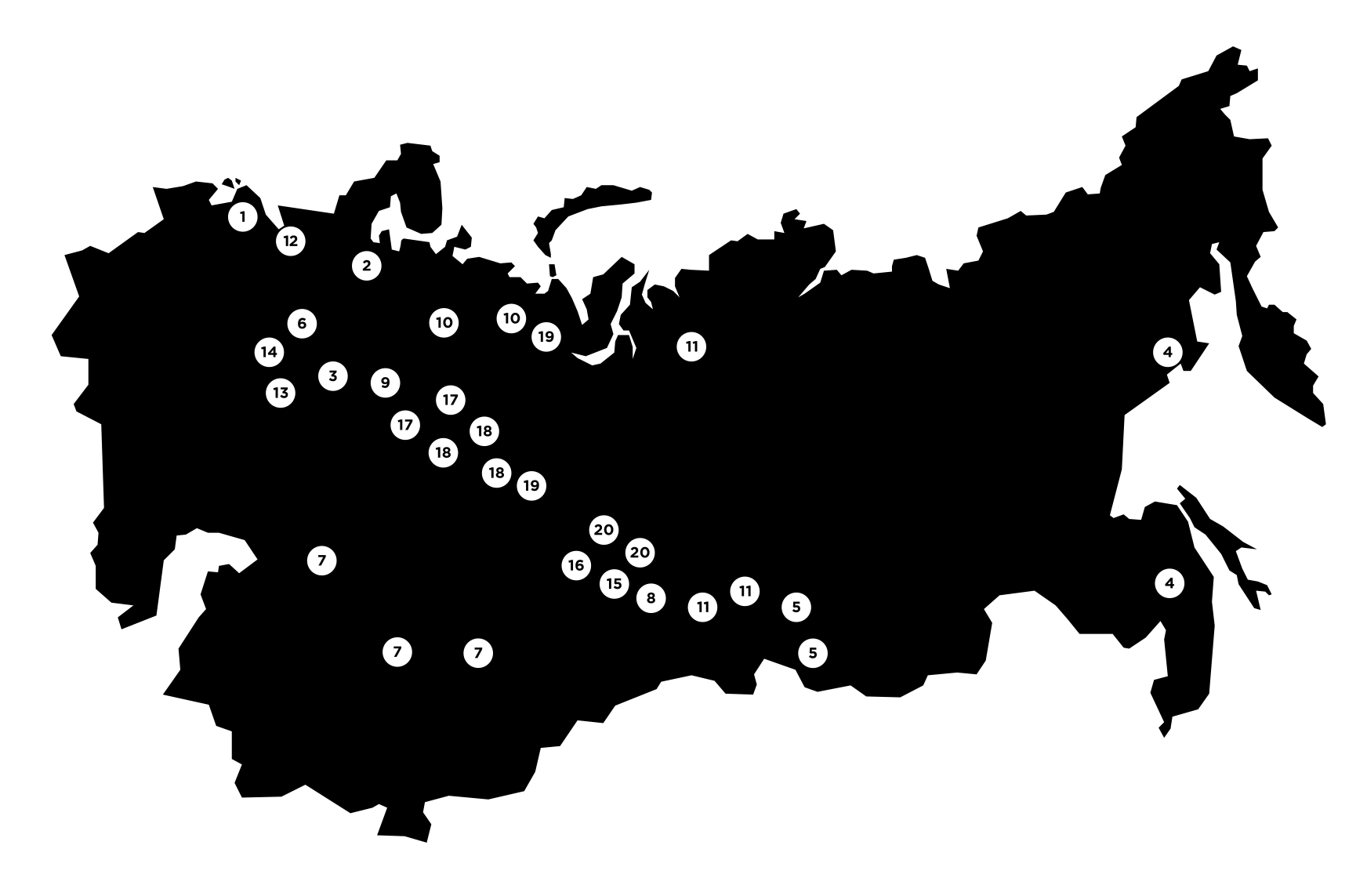
KAARDIL:
- ESTONIA
- ARKHANGELSK OBLAST
- GORKY (NIZHNY NOVGOROD) OBLAST
- HABAROVSK KRAI / MAGADAN OBLAST
- IRKUTSK OBLAST
- YAROSLAVL OBLAST
- KAZAKH SSR
- KEMEROVO OBLAST
- KIROV OBLAST
- KOMI ASSR
- KRASNOYARSK KRAI
- LENINGRAD OBLAST
- MORDOVIAN ASSR
- MOSCOW
- NOVOSIBIRSK OBLAST
- OMSK OBLAST
- PERM (MOLOTOV) OBLAST
- SVERDLOVSK OBLAST
- TYUMEN OBLAST
- TOMSK OBLAST
Search in the electronic memorial
By using the search window, you can find information in the electronic memorial on persons who suffered in the communist terror and you will find instructions for finding their names on the name plaques.
